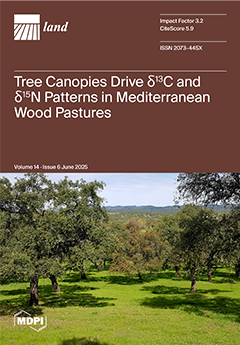An adequate food supply is a core issue for sustainable development worldwide. Amid greater instability in the food supply triggered by more armed conflicts, trade disputes, and climate change, a decline in grain cultivation area still plagues many regions. China, a major food
[...] Read more.
An adequate food supply is a core issue for sustainable development worldwide. Amid greater instability in the food supply triggered by more armed conflicts, trade disputes, and climate change, a decline in grain cultivation area still plagues many regions. China, a major food producer globally, is a case in point. The truth is that at the moment, the formulation and implementation of policies as well as academic discussions regarding this issue are predominantly based on the sown area of grains, overlooking the fundamental role co-played by population, yield efficiency, and sown area in determining food supply. Furthermore, the commonly used indicator, the non-grain cultivation rate, fails to directly reflect the impact of the phenomenon on the grain supply. To address these gaps, this study introduces trend-change detection and factor-contribution analysis, uses long-term grain sown area data to identify regions with significant grain retreat, and quantifies the relative influence of population shifts, crop yield improvements, and sown area changes on food supply. Key findings include the following: China’s total grain production maintained steady growth from 2003 to 2023, far exceeding conventional food security thresholds. Temporary reductions in grain sown area (2015–2019, 2021–2022) were offset by rising yields, with no substantial decline in supply. Twelve provinces/municipalities, Beijing, Shanghai, Zhejiang, Fujian, Guangdong, Guangxi, Guizhou, Shaanxi, Ningxia, Sichuan, Chongqing, and Hainan, exhibited substantial declines in grain plantation. However, Sichuan and Shaanxi achieved counter-trend growth in food supply, while Ningxia and Guizhou experienced frequent fluctuations. The sown area was not always the dominant factor in per capita grain availability. Yield increases neutralized cropland reduction in Sichuan, Shaanxi, Guizhou, and Ningxia, whereas population inflows outweighed the sown area effect in the other eight provinces. The study concludes that China’s grain cropland reduction has not yet posed a threat to national food security. That said, the spatial concentration of these affected regions and their ongoing output reductions may raise domestic grain redistribution costs and intensify inter-regional conflicts over cropland protection. Meanwhile, population influx plays a similarly important role to that of grain plantation decline in the grain supply. Considering that, we believe that more moderate measures should be adopted to address the shrinkage of grain planting areas, with pre-set food self-sufficiency standards. These measures include, but are not limited to, improving productivity and adopting integrated farming. Methodologically, this work lowers distortions from normal annual cropland fluctuations, enabling more precise identification of non-grain production zones. By quantifying the separate impacts of population, crop yield, and sown area changes, it supplements existing observations on grain cropland decline and provides better targeted suggestions on policy formulation and coordination.
Full article





